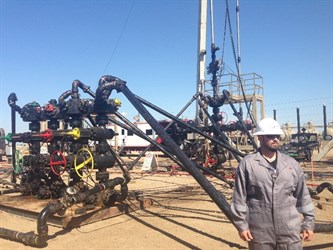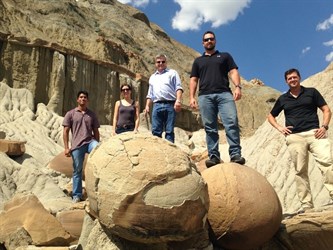A team of four graduate students and two advisers, part of the Hydraulic Fracture Conductivity and Rock Mechanics Research Group in the Harold Vance Department of Petroleum Engineering at Texas A&M University, traveled to Williston, North Dakota to witness firsthand an in-field multi-stage fracturing job and related operations on the Bakken formation this summer. The field trip, nicknamed “Rockin’ the Bakken” by advisers Dr. Ding Zhu and Dr. A. Daniel Hill, offered the team a huge opportunity to step out of the lab and into a real-time, real-life field learning experience.

Team members Dante Guerra, Jesse Guerra, Ashley Knorr, and Omar Enriquez Tenorio say their research focuses primarily on investigating parameters that affect hydraulic fracture conductivity in unconventional reservoirs, including fluid interactions, rock mechanics, and mineralogical properties, with the primary goal of contributing to a better understanding on the subject that ultimately can be applied in the design and optimization of hydraulic fracturing operations.
Dr. C. Mark Pearson, president of Liberty Resources, LLC, coordinated all activities of the field trip for the team and the advisors. Allen Penman, district manager of Liberty Oilfield Services, provided a walkthrough of the Williston facilities on the first day. During the next two days, Pearson offered the group a chance to witness the hydraulic fracturing operations.
While on site, the team experienced the raw feel of a hydraulic fracturing operation, with its inherent complexity and protocols involved, as the three main targets of most operator and service companies in unconventional plays were sought: improving completion time, increasing hydraulic fracturing efficiency and maximizing production.

The pad they visited featured three adjacent horizontal wells on it, all oriented in a north-south direction, and all part of a grand design to centralize operations and surface facilities. Having adjacent wells on one pad optimizes both drilling operations and completion operations, saving time and money. Key standard components on site were the data monitoring van, fracturing pumps/semi tractors, fracturing blenders, chemical storage tanks, hydration unit, sand and fracturing fluid storage tanks and delivery units, water tanks (for water piped from several miles away), and the manifold.
The fracturing operation employed is often referred to as zipper frac, meaning hydraulically fracturing adjacent wells in an alternating fashion, one stage per well at a time. This results in running wire lines to plug and perforate in one well, while another well is being hydraulically fractured. By doing this, substantial time is saved and a larger amount of stages can be achieved.

The zipper frac manifold was labeled with green, red, and yellow coloring to distinguish between wells during the operations. Operations were overseen within the data monitoring van, ensuring all activities occurred as planned.

“Being able to see cutting edge technology and practices in the field allowed me to gain a deeper understanding of hydraulic fracturing beyond what I have acquired in the classroom or from textbooks,” said Dante Guerra. “This experience allowed me to have one-on-one discussions with experts in their field and gain further insight into the challenges currently faced by pioneers in the oil and gas industry — challenges we hope to overcome with our research at Texas A&M.”
The Bakken shale formation in the Williston basin is estimated to contain the largest continuous unconventional oil resource in the lower 48 states. The formation spans approximately 200,000 square miles of the subsurface of the Williston Basin, in parts of Montana, North Dakota, Saskatchewan and Manitoba. The North Dakota area was first explored by oil companies in the 1950’s but the technology of the time could only focus on conventional resources. Since the shale formation has low permeability and porosity, enhanced recovery techniques such as hydraulic fracturing are required for this unconventional resource.
Current technological developments and the amalgamation of hydraulic fracturing and horizontal drilling have enabled production in such unconventional reservoirs. Horizontal and directional drilling allows the wellbore greater exposure to the formation. Hydraulic fracturing provides a path for trapped oil and gas to flow from the formation to the wellbore by creating a network of connected fractures held open by proppants, such as sand or man-made ceramic materials.
Because of its size and potential as an oil and gas resource, the Bakken has been one of the formations contributing to the energy production resurgence in the U.S. in the last few years. Many of the operational experiences and technical knowledge gained here are applied to other unconventional reservoirs, such as the Eagle Ford shale formation in south Texas. Such experiences and knowledge are of direct relevance to the Hydraulic Fracture Conductivity and Rock Mechanics Research Group, since their research scope is directly related to in-field operations.
“Sharing knowledge and experiences allows both academia and industry to enrich their understanding of unconventional reservoirs and how to best produce them,” said Jesse Guerra. “By balancing both classroom and hands-on field learning, we as petroleum engineering graduate students will not only develop a concrete background in the subject, but will also lead and innovate as new challenges present themselves in the future.”

In the end, the trip was not all work and no play. Omar, Ashley, Dr. Hill, Dante, and Jesse did find time to explore the unusual geological formations named cannon ball concretions at the Theodore Roosevelt National Park while Dr. Zhu took pictures.